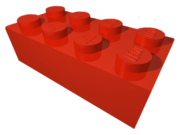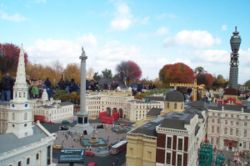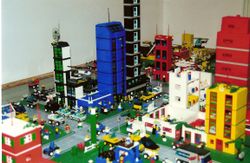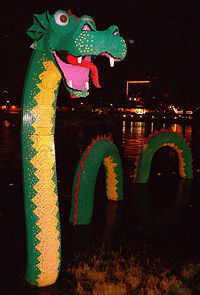Lego
2008/9 Schools Wikipedia Selection. Related subjects: Games
Lego, officially trademarked LEGO, is a line of construction toys manufactured by the Lego Group, a privately held company based in Denmark. The company's flagship product, "Lego bricks", have consisted of colorful interlocking plastic bricks and an accompanying array of gears, minifigures and various other parts. Lego bricks can be assembled and connected in many ways, to construct such objects as vehicles, buildings and even working robots. Anything constructed can then be conveniently taken apart again, and the pieces used to make other objects. Kits are sold which contain all necessary pieces for a particular project, or some hobbyists try to collect, buy, and sell various other pieces in different shapes and colors, to construct other hobbyist-created designs. The toys were originally designed in the 1940s in Europe and have achieved an international appeal, with an extensive subculture that supports Lego movies, games, competitions, and four Lego-themed amusement parks.
Early history
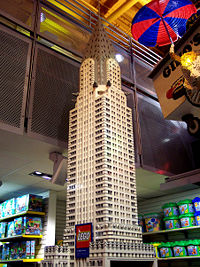
The Lego Group had a very humble beginning in the workshop of Ole Kirk Christiansen, a carpenter from Billund, Denmark. Christiansen began creating wooden toys in 1932; the company began calling itself "Lego" two years later in 1934. The company expanded to producing plastic toys in 1940. In 1949, Lego began producing the now-famous interlocking bricks, calling them "Automatic Binding Bricks". These bricks were based largely on the design of Kiddicraft Self-Locking Bricks, which were released in the UK in 1947. The first Lego bricks, manufactured from cellulose acetate, were developed in the spirit of traditional wooden blocks that could be stacked upon one another; however, these plastic bricks could be "locked" together. They had several round "studs" on top, and a hollow rectangular bottom. The blocks snapped together, but not so tightly that they could not be pulled apart.
The company name Lego was coined by Christiansen from the Danish phrase leg godt, which means "play well". The name could also be interpreted as "I put together" or "I assemble" in Latin, though this would be a somewhat forced application of the general sense "I collect; I gather; I learn"; the word is most used in the derived sense, "I read". The cognate Greek verb "λέγω" or "lego" also means "gather, pick up", but this can include constructing a stone wall.
The Lego Group's motto is "Only the best is good enough", a free translation of the Danish phrase Det bedste er ikke for godt. This motto was created by Ole Kirk to encourage his employees never to skimp on quality, a value he believed in strongly. The motto is still used within the company today.
The use of plastic for toy manufacture was not highly regarded by retailers and consumers of the time. Many of the Lego Group's shipments were returned, following poor sales; it was thought that plastic toys could never replace wooden ones.
By 1954, Christiansen's son, Godtfred Kirk Christiansen, had become the junior managing director of the Lego Group. It was his conversation with an overseas buyer that struck the idea of a toy system. Godtfred saw the immense potential in Lego bricks to become a system for creative play, but the bricks still had some problems from a technical standpoint: their "locking" ability was limited, and they were not very versatile. It was not until 1958 that the modern-day brick design was developed, and it took another five years to find exactly the right material for it. The modern Lego brick was patented on January 28, 1958, and bricks from that year are still compatible with current bricks.
Design and manufacture
Lego pieces of all varieties have been, first and foremost, part of a universal system. Despite tremendous variation in the design and purpose of individual pieces over the years, each remains compatible in some way with existing pieces. Lego bricks from 1963 still interlock with those made in 2008, and Lego sets for young children are compatible with those made for teenagers.
Bricks, beams, axles, mini figures, and all other elements in the Lego system are manufactured to an exacting degree of tolerance. When snapped together, pieces must have just the right amount of "clutch power"; they must stay together until pulled apart. They cannot be too easy to pull apart, or the resulting constructions would be unstable; they also cannot be too difficult to pull apart, since the disassembly of one creation in order to build another is part of the Lego appeal. In order for pieces to have just the right "clutch power", Lego elements are manufactured within a tolerance of 2 µm.
Since 1963, Lego pieces have been manufactured from a strong, resilient plastic known as acrylonitrile butadiene styrene, or ABS. Precision-machined, small-capacity molds are used, and human inspectors check the output of the molds, to eliminate significant variations in colour or thickness. Worn-out molds are encased in the foundations of buildings to prevent their falling into competitors' hands. According to the Lego Group, about eighteen bricks out of every million fail to meet the standard required. Only one percent of the plastic waste in Lego factories goes unrecycled.
Manufacturing of Lego bricks occurs at a number of locations around the world. Molding is done at one of two plants in Denmark and Czech Republic. Brick decorations and packaging is done at plants in Denmark, United States, Mexico and the Czech Republic. Annual production of Lego bricks averages approximately 20 billion (2×1010) per year, or about 600 pieces per second. To put this in context, if all the Lego bricks ever produced were to be divided equally among a world population of six billion, each person would have 62 Lego bricks.
In 2007, Lego Group announced a restructuring of the current production setup including the outsourcing of some of the production work to Flextronics, a Singaporean electronics company. Lego Group plans to close the production facility in Enfield, Connecticut and outsource this work to the Flextronics factory in Mexico. Flextronics will also oversee the factory in Kladno, Czech Republic. The Czech facilities would also be expanded due to the planned closing of the Swiss factory in Baar, which mostly manufactured TECHNIC parts. On February 19, 2008, Lego announced that the Lego Group would instead take over operations of the Kladno factory from March 1, 2008.
Today
Since it began producing plastic bricks, the Lego Group has released thousands of play sets themed around a variety of topics. Examples include, but are not limited to, space, robots, pirates, vikings, medieval castles, dinosaurs, holiday locations, scuba diving, the wild west, the Arctic, airports, miners, Star Wars, Batman, SpongeBob SquarePants, Harry Potter, Indiana Jones and Lego Speed Racer. New elements are often released along with new sets. There are also Lego sets designed to appeal to young girls such as the Clikits line which consists of small interlocking parts that are meant to encourage creativity and arts and crafts, much like regular Lego bricks. Clikit pieces can interlock with regular Lego bricks as decorative elements.
The Lego range has expanded to encompass accessory motors, gears, lights, sensors, and cameras designed to be used with Lego components. There are even special bricks, like the Lego NXT that can be programmed with a PC or a Mac to perform very complicated and useful tasks. These programmable bricks are sold under the name Lego Mindstorms.
In 2006 a new Lego Mindstorms kit called Mindstorms NXT was released. It is more advanced than the previous RCX, and has a new array of sensors. They include touch, sound, light, and a new ultrasonic sensor technology. There is also a Bluetooth compatible hookup that can send and receive messages from one's cellphone and other Bluetooth compatible devices. The RCX was only compatible with Windows, but the NXT is compatible with both Windows and Mac OS.
There are several robotics competitions which use Lego bricks and the RCX. The earliest, and likely the largest, is Botball, a national U.S. middle- and high-school competition stemming from the MIT 6.270 Lego robotics tournament. A related competition is FIRST Lego League for elementary and middle schools. The international RoboCup Junior soccer competition involves extensive use of Lego Mindstorms equipment which is often pushed to its extreme limits.
Bionicle is a line of toys by the Lego Group that is marketed towards those in the 7–16-year-old age range. The line was launched in January 2001 in Europe and June/July 2001 in the United States. The Bionicle idea originated from the earlier toy lines Slizers (also known as Throwbots) and Roboriders. Both of these lines had similar throwing disks and characters based on classical elements. The sets in the Bionicle line have increased in size and flexibility through the years.
Lego Group operates four Legoland amusement parks, the original in Billund, Denmark, the second in Windsor England and the third in Gunzburg, Germany, there is also one in California. On July 13, 2005, the control of 70% of the Legoland parks was sold for $460 million to the Blackstone Group of New York while the remaining 30% is still held by the Lego Group. There are also several Lego Brand retail stores, including at Downtown Disney in both the Disneyland and Walt Disney World Resorts and in the Mall of America in Bloomington, Minnesota. As of year end 2005, there are 25 Lego Brand Retail stores in the USA, a number of stores in Europe, and a franchised Lego store in Abu Dhabi.
Lego has also successfully branched into video games that appeal to a wide age range, with titles like Lego Star Wars: The Video Game, Lego Star Wars II: The Original Trilogy, Bionicle Heroes as well as the Lego Star Wars: The Complete Saga, the upcoming Lego Universe MMOG, Lego Batman, and Lego Indiana Jones. Lego Digital Designer is an official piece of Lego software for Windows and Mac OS X which allows users to build with Lego bricks on their computers. Users can then publish their creations online on the Lego Factory website, or purchase the physical bricks to build them. Lego Digital Designer includes some Lego products which only exist online, including models for the children's television programmes TUGS, Thomas and Friends and Speed Racer.
On January 28, 2008, Lego celebrated the 50th anniversary of the patent on its interlocking blocks with a worldwide building contest. Google paid tribute to the anniversary by writing its name on the Google homepage in Lego bricks, along with the Lego figure on one of the letters.
In art
One hobby among enthusiasts is to make short movies or recreations of feature films using Lego bricks. Such movies are called "Lego movies", " Brickfilms", "Legomations", "Brick Flicks" and "cinema Lego". They usually use stop motion animation. For example, the Monty Python and the Holy Grail special edition DVD contained a version of the Camelot musical sequence redone with Lego minifigures and accessories.
Lego used to sell a line of sets named "Lego Studios" (now discontinued), which contains a Lego web cam (repackaged Logitech USB Quickcam Web), software to record video on a computer, black plastic rods which can be used to manipulate minifigures from off-camera and a minifigure resembling Steven Spielberg. Because of the low quality of the camera and software most Brickfilmers do not use it.
Another notable example is the award-winning music video for the song " Fell in Love with a Girl" by the White Stripes. Director Michel Gondry filmed a live version of the video, digitized the result and then recreated it entirely with Lego bricks.
Artists have also used Lego sets with one of the more notorious examples being Polish artist Zbigniew Libera's " Lego Concentration Camp", a collection of mock Lego sets with a concentration camp theme.
The Little Artists have created an entire Modern Art collection in a Lego Gallery. ' Art Craziest Nation' was shown at the Walker Art Gallery in Liverpool, UK. Such ambitious projects are sometimes called ‘Lego art’ or ‘brick art’.
Several webcomics are illustrated with Lego, notably Legostar Galactica, Captain Ahnee & the Dipwads Part 1 and Part 2, and Irregular Webcomic!. Brendan Powell Smith has created an illustrated bible using Lego bricks, called the Brick Testament. Nathan Sawaya is a professional Lego artist who currently has a museum show of Lego sculptures and Mosaics touring the US. Jason Burik is also an artist who provides Lego art to the world.
Serious Play
Since around 2000, the Lego Group has been promoting Lego Serious Play, a form of business consultancy fostering creative thinking, in which team members build metaphors of their organizational identities and experiences using Lego bricks. Participants work through imaginary scenarios using visual three-dimensional Lego constructions, imaginatively exploring possibilities in a serious form of play.
Trademark
The Lego Group's name has become so synonymous with its flagship toy that many refer to the bricks themselves (collectively) as "Lego" or "Legos" (the latter term being common only in US English), although the Lego Group considers such uses to be trademark dilution. Lego catalogues in the 1970s and 1980s contained a note that read:
"The word LEGO® is a brand name and is very special to all of us in the LEGO Group Companies. We would sincerely like your help in keeping it special. Please always refer to our bricks as 'LEGO Bricks or Toys' and not 'LEGOS.' By doing so, you will be helping to protect and preserve a brand of which we are very proud and that stands for quality the world over. Thank you! Susan Williams, Consumer Services."
The official Lego website is www.lego.com. For many years, visitors to www.legos.com (also registered to the Lego Group) have received notices similar to the one pictured, and were intentionally redirected to the official website, to further protect the brand.
"Lego" is officially written in all uppercase letters. The company asserts that to protect its brand name, the word Lego must always be used as an adjective, as in "Lego set", "Lego products", "Lego universe", and so forth.
